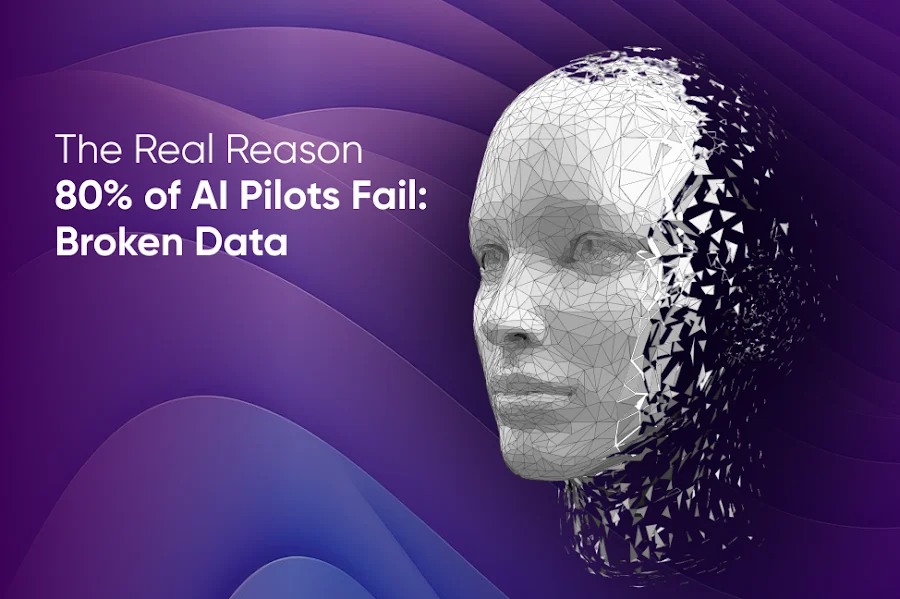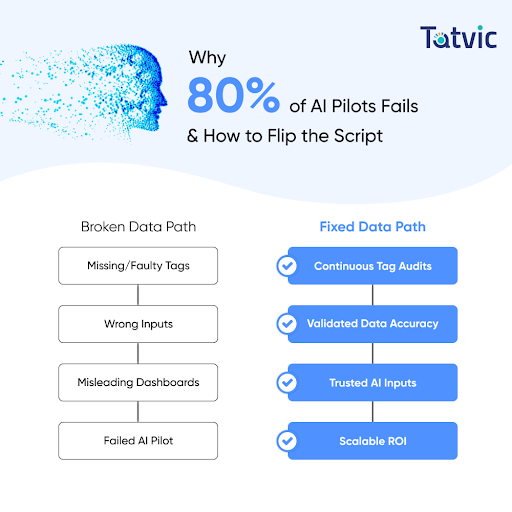When you hear that 80% of AI pilots fail, it sounds shocking but not surprising. Many leaders assume the cause is a lack of AI maturity, limited technical talent, or organizational resistance. These are the usual explanations.
But one of the most overlooked reasons AI pilots fail isn’t a lack of ambition or cutting-edge algorithms. It’s something far more fundamental, and often overlooked: broken data.
You’ve probably felt this pain first-hand – investments in AI pilots that promised ROI but never scaled, months of effort undermined by blind spots you only discover much later, and decisions based on dashboards that don’t reflect reality.
The culprit? Data that was never captured, misclassified, or silently broken before it ever reached your AI system.
Broken Data in the Real World
So, what does broken data really look like in the trenches of marketing and technology? Not abstract quality issues, but everyday failures that quietly sabotage AI pilots:
- Missing tags: Your high-budget campaign runs, but a missing conversion tag means none of the outcomes are logged. When AI models try to optimize campaigns, they’re working blind.
- Faulty tag implementation: Tags are present, but mapped incorrectly. A lead form submission shows up as a generic “page view.” The system optimizes for noise instead of real business signals.
- Silent GA gaps: Critical customer interactions aren’t being collected in Google Analytics – and the team only realizes weeks later, when performance reports look suspiciously low. By then, opportunities are already lost.
- Data layer pitfalls: Development teams are tasked with implementing tags via data layer snippets. Delays, overlooked dependencies, or small coding errors mean the AI receives patchy or inconsistent data.
- Audit blind spots: Without systematic tag audits, broken setups persist unnoticed. AI models churn confidently on flawed inputs, creating outputs that look valid but steer strategy in the wrong direction.
This is the silent sabotage of broken data. It doesn’t show up with warning signs, it lurks in the background, distorting the foundation your AI relies on. By the time the issue is spotted, the pilot has already underdelivered.
 Why Leaders Feel the Frustration
Why Leaders Feel the Frustration
For senior leaders responsible for AI adoption, this problem is more than a technical nuisance – it’s a business headache.
- Investment vs. outcome mismatch: You’ve funded an AI pilot expecting efficiency or revenue lift, only to see minimal impact because the underlying data collection was flawed.
- Scaling failures: Even if a pilot works in a controlled environment, scaling exposes inconsistencies. Suddenly, broken tags or misaligned categories across regions or products amplify errors.
- Eroding confidence: Each failed AI initiative creates skepticism across teams and the boardroom. Leaders hesitate to back new pilots, slowing transformation while competitors push forward.
This cycle repeats not because AI is inherently unreliable, but because the data feeding it is inaccurate, incomplete, or simply missing.
Why Broken Data Persists
If leaders know data accuracy and data quality are critical, why do broken setups continue to cripple AI pilots?
- Complex tracking environments: Modern marketing and analytics rely on hundreds of tags across websites, apps, and customer journeys. One misstep in tag setup snowballs into broken insights.
- Dynamic Environment – With the ever-increasing developments on Apps and Websites, it becomes difficult for analysts to keep up with audit requirements, even when new implementations get audited, older implementations are likely to be ignored.
- Speed over validation: In today’s fast-paced environment with tight deadlines, teams often skip rigorous audits of tag setups and data collection pipelines. The result: projects and AI Pilots run on incomplete data.
- Lack of continuous monitoring: Most companies validate tags at setup but don’t continuously check database accuracy. Over time, integrations break, behaviors change, and data quietly drifts.
The bottom line: AI can’t outperform the data it’s trained on. If the signals are wrong, the outputs will be wrong – no matter how advanced the model.
AI Pilot ROI Depends on Data Trustworthiness
Here’s the hard truth: Agentic AI ROI depends less on the brilliance of the algorithm and more on the reliability of the data feeding it.
- A personalization pilot with incomplete tags delivers irrelevant, even off-putting results.
- A fraud detection model with wrong event categories flags real customers while missing fraud.
Without accurate, complete, validated data, even the best models collapse under weak foundations.
That’s why data trust is the first checkpoint before we deploy Agentic AI in any process. Once the foundation is stable, autonomous agents can focus on what they do best – driving measurable ROI at scale.
Want to see where autonomous agents can create the biggest business impact? Explore our blog on The Agentic AI Sweet Spot: Where Can Autonomous Agents Drive Maximum ROI in Your Marketing?
The Missing Link: Continuous Data Validation
The real solution isn’t a one-time audit or cleanup. Tagging setups and data pipelines degrade constantly – campaigns change, websites are updated, integrations break, and customer behavior evolves.
What’s needed is continuous validation of tags, categories, and data flows. Leaders need assurance that data collection is not only implemented correctly but remains reliable day after day.
This is where database accuracy and data quality shifts from back-office concerns to boardroom priorities. Because without them, AI initiatives are set up to fail.
Introducing Agentic AI for Smarter Data Measurement
This is exactly where Agentic AI for smarter data measurement comes into play.
Unlike traditional measurement, which checks outcomes after the fact, the Agentic AI Measurement toolkit intervenes throughout the AI lifecycle:
- Continuously audits tags
- Validates data accuracy in real time
- Detects missing or misclassified inputs before they reach the model
- Ensures trustworthy data streams that scale reliably
For leaders, this means confidence that:
- GA events fire correctly
- Data layers are error-free
- AI models receive reliable signals – not distorted noise
In short: AI pilots built on validated, accurate data – pilots that actually deliver ROI.
From Pilot Failure to Scalable Success
The harsh truth is that AI pilot failure will remain the default until organizations confront broken data head-on. But the hopeful truth is this: with the right tools, leaders can flip the narrative.
- From pilots that stall → to AI initiatives that scale.
- From skepticism in the boardroom → to repeatable, measurable ROI.
- From lagging behind competitors → to driving AI innovation that sticks.
This blog kicks off a new series on Tatvic’s Agentic AI for Smarter Data Measurement – the antidote to broken data.
In the coming weeks, we’ll dive deeper into how this toolkit goes beyond outcome reporting to continuously audit tags, validate database accuracy, and safeguard the integrity of your AI pipelines.
For now, the takeaway is clear: AI doesn’t fail – broken data does. Fixing it is the first step to unlocking meaningful, scalable AI ROI.
Want to ensure your AI pilots deliver measurable ROI, not broken outcomes? Discover how Tatvic’s Agentic AI Services can help you build smarter, scale faster, and achieve trustworthy AI adoption.


 Why Leaders Feel the Frustration
Why Leaders Feel the Frustration